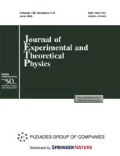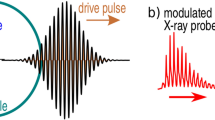Abstract
The generation of multimegawatt terahertz pulses based on the superradiance of picosecond electron bunches moving in a periodic magnetic (undulator) field is shown to be possible. The theoretical study of superradiance processes is based both on the method of an averaged ponderomotive force and on direct numerical PIC (particle in cell) simulations. The analysis is performed in the K′ reference frame comoving with the electrons followed by the recalculation of radiation characteristics to the laboratory frame using the Lorentz transformations. Within the framework of the averaged approach, the electron bunch is represented as an ensemble of macroelectrons interacting between themselves through the radiation fields and Coulomb forces. The superradiance effect includes particle bunching followed by coherent emission of a single intense pulse from the entire volume of an electron bunch whose length exceeds considerably the wavelength. PIC simulations of this process based on the KARAT code have been performed for a more detailed analysis including the transverse inhomogeneity of the undulator field, the relativistic pattern of electron motion in this field, etc. A considerable simplification of the calculation procedure when passing to the comoving reference frame due to the commensurability of all spatial scales, including the radiation wavelength, the bunch length, and the length of the train of the pump wave into which the undulator field is transformed, is shown to be possible.
Similar content being viewed by others
References
N. S. Ginzburg, A. S. Sergeev, I. V. Zotova, I. V. Zotova, A. S. Sergeev, I. V. Konoplev, A. D. R. Phelps, A. W. Cross, S. J. Cooke, V. G. Shpak, M. I. Yalandin, S. A. Shunailov, and M. R. Ulmaskulov, Phys. Rev. Lett. 78, 2365 (1997).
N. S. Ginzburg, Yu. V. Novozhilova, A. S. Sergeev, N. Yu. Novozhilova, I. V. Zotova, A. S. Sergeev, N. Yu. Peskov, A. D. R. Phelps, S. M. Wiggins, A. W. Cross, K. Ronald, W. He, V. G. Shpak, M. I. Yalandin, S. A. Shunailov, M. R. Ulmaskulov, and V. P. Tarakanov, Phys. Rev. E: Stat. Phys., Plasmas, Fluids, Relat. Interdiscip. Top. 60, 3297 (1999).
A. A. El’chaninov, S. D. Korovin, V. V. Rostov, I. V. Pegel’, G. A. Mesyats, M. I. Yalandin, and N. S. Ginzburg, JETP Lett. 77(6), 266 (2003).
A. A. El’chaninov, A. I. Klimov, O. B. Koval’chuk, G. A. Mesyats, I. V. Pegel’, I. V. Romanchenko, V. V. Rostov, K. A. Sharypov, and M. I. Yalandin, Tech. Phys. 56(1), 121 (2011).
N. S. Ginzburg and A. S. Sergeev, JETP Lett. 54(8), 446 (1991).
N. S. Ginzburg, A. S. Sergeev, and A. M. Malkin, J. Exp. Theor. Phys. 96(5), 904 (2003).
R. H. Bonifacio, C. Maroli, and N. Piovella, Opt. Commun. 68, 369 (1988).
R. H. Bonifacio, N. Piovella, and B. W. J. McNeil, Phys. Rev. A: At., Mol., Opt. Phys. 44, 3441 (1991).
G. R. M. Robb, N. S. Ginzburg, A. D. R. Phelps, and A. S. Sergeev, Phys. Rev. Lett. 77, 1492 (1996).
J. G. Power, in AIP Conf. Proc. 1299, 20 (2010).
P. Piot, Y. Sun, and K. Kim, Phys. Rev. Spec. Top.—Accel. Beams 9, 031001 (2006).
V. P. Tarakanov, User’s Manual for Code KARAT (Berkeley Research Associates, Springfield, Virginia, United States, 1992).
N. S. Ginzburg, I. V. Zotova, A. M. Malkin, and V. P. Tarakanov, Tech. Phys. Lett. 38(6), 531 (2012).
J. L. Vay, Phys. Rev. Lett. 98, 130405 (2007).
C. G. R. Geddes, D. L. Bruhwiler, J. R. Cary, W. B. Mori, J.-L. Vay, S. F. Martins, T. Katsouleas, E. Cormier-Michel, W. M. Fawley, C. Huang, X. Wang, B. Cowan, V. K. Decyk, E. Esarey, R. A. Fonseca, W. Lu, P. Messmer, P. Mullowney, K. Nakamura, K. Paul, G. R. Plateau, C. B. Schroeder, L. O. Silva, C. Toth, F. S. Tsung, M. Tzoufras, T. Antonsen, J. Vieira, and W. P. Leemans, J. Phys.: Conf. Ser. 125, 12002 (2008).
Author information
Authors and Affiliations
Corresponding author
Additional information
Original Russian Text © N.S. Ginzburg, A.A. Golovanov, I.V. Zotova, A.M. Malkin, V.P. Tarakanov, 2014, published in Zhurnal Eksperimental’noi i Teoreticheskoi Fiziki, 2014, Vol. 146, No. 4, pp. 720–729.
Rights and permissions
About this article
Cite this article
Ginzburg, N.S., Golovanov, A.A., Zotova, I.V. et al. Undulator superradiance effect and its applicability for the generation of multimegawatt terahertz pulses. J. Exp. Theor. Phys. 119, 632–640 (2014). https://doi.org/10.1134/S1063776114100021
Received:
Published:
Issue Date:
DOI: https://doi.org/10.1134/S1063776114100021



